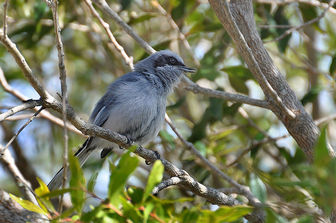Masked Gnatcatcher
Its jizz is similar to that of other gnatcatchers; a small bird with a relatively long thin bill, a long frequently cocked tail, and grey upperparts. The central rectrices are black, while the outer are white , and there is a white patch in the wing . Males of the southern and western group , the Masked Gnatcatchers in the strict sense, have grey underparts and a broad black mask. Females lack the mask, but instead have a black patch behind the eyes on the auriculars. The northern nominate subspecies dumicola is distinctive, with white underparts in both sexes, and a narrow black mask in the male. It may be a separate species, Berlepsch's Gnatcatcher.

Original source: Balança-rabo-de-máscara (Polioptila dumicola dumicola) - MachoUploaded by Snowmanradio
Author: Cláudio Dias Timm from Rio Grande do SulCamera location
The Masked Gnatcatcher is classified as Least Concern. Does not qualify for a more at risk category. Widespread and abundant taxa are included in this category.
The Masked Gnatcatcher (Polioptila dumicola) is a small active insectivorous songbird, found in northern Argentina, Uruguay, Paraguay, Bolivia and southern and central Brazil. It is found in a wide range of semi-open habitats, including dry forest and Cerrado. It is generally fairly common, and consequently considered to be of least concern by BirdLife International and IUCN. More
The Masked Gnatcatcher, Polioptila dumicola, is endemic to south-east Par More
The Masked Gnatcatcher is found from south-east Pará to northern Argentina where it inhabits light woodland, gallery woodland and scrub such as the chaco where it is quite common. Male Masked Gnatcatcher, Brasília, Brazil, July 2006 The nominate sub-species is blue-grey above and a lighter grey below with blackish wings edged white. The tail is black with white outer feathers. More

Original source: Cl
Author: Cl
Permission: Some rights reserved
Family : Polioptilidae
Genus : Polioptila
Species : dumicola
Authority : (Vieillot, 1817)
